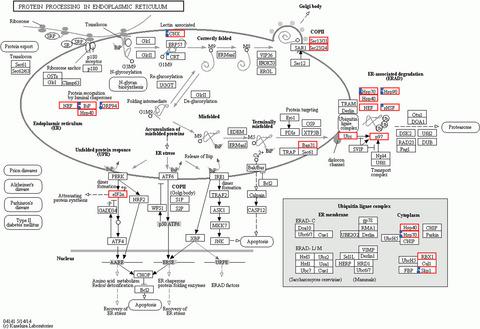当前位置:
X-MOL 学术
›
Food Energy Secur.
›
论文详情
Our official English website, www.x-mol.net, welcomes your
feedback! (Note: you will need to create a separate account there.)
Integrated proteome and transcriptome analyses revealed key factors involved in tomato (Solanum lycopersicum) under high temperature stress
Food and Energy Security ( IF 4.0 ) Pub Date : 2020-08-19 , DOI: 10.1002/fes3.239 Haidong Ding 1, 2 , Shuangrong Mo 1 , Ying Qian 1 , Guibo Yuan 1 , Xiaoxia Wu 1, 2 , Cailin Ge 1, 2
Food and Energy Security ( IF 4.0 ) Pub Date : 2020-08-19 , DOI: 10.1002/fes3.239 Haidong Ding 1, 2 , Shuangrong Mo 1 , Ying Qian 1 , Guibo Yuan 1 , Xiaoxia Wu 1, 2 , Cailin Ge 1, 2
Affiliation

|
High temperature (HT) is an important environmental factor affecting crops growth, development, and yield. Transcriptome and proteome technologies developed in recent years can provide deeper and more reliable data to decipher the mechanisms of HT response. In the present study, the transcriptome analysis with RNA sequencing (RNA‐Seq) and integrative analysis on obtained proteomic data were performed in tomato (Solanum lycopersicum) leaves under HT stress (42°C for 4 hr). In total, 3,531 differentially expressed genes (DEGs) and 268 differentially expressed proteins (DEPs) were explored. The quantitative data were validated by qRT‐PCR and parallel reaction monitoring (PRM). Upon mapping of the DEGs/DEPs to the KEGG pathway database, “protein processing in the endoplasmic reticulum” was found to be the most significant enrichment pathway both at the transcriptional and protein levels, suggesting that endoplasmic reticulum stress may play a central role in HT tolerance. Furthermore, transcriptome‐proteome integrative analysis revealed 91 genes shared both in DEGs and DEPs, of which 79 correlations with the same changing trends were most associated with stress response and protein folding. Among these, a HT response gene designated SlBAG5 of unknown function received attention. The full‐length of SlBAG5 was cloned and ectopically overexpressed in Arabidopsis, which displayed thermosensitive phenotype. Taken together, this work provides deep insight into the molecular mechanisms of plant thermotolerance and also facilitates the identification of the key potential genes/proteins for HT response.
中文翻译:

综合的蛋白质组和转录组分析揭示了高温胁迫下番茄(Solanum lycopersicum)涉及的关键因素
高温是影响作物生长,发育和产量的重要环境因素。近年来开发的转录组和蛋白质组技术可以提供更深入,更可靠的数据来解释HT反应的机制。在本研究中,在番茄(Solanum lycopersicum)中进行了具有RNA测序(RNA-Seq)的转录组分析和对获得的蛋白质组数据的综合分析。)叶片在HT胁迫下(42°C持续4 hr)。总共研究了3,531个差异表达基因(DEG)和268个差异表达蛋白(DEP)。定量数据通过qRT-PCR和平行反应监测(PRM)进行了验证。在将DEGs / DEPs映射到KEGG途径数据库后,发现“内质网中的蛋白质加工”是转录和蛋白质水平上最重要的富集途径,这表明内质网应激可能在HT中起核心作用公差。此外,转录组-蛋白质组整合分析显示DEG和DEP中共有91个基因,其中79个具有相同变化趋势的相关性与应激反应和蛋白质折叠最相关。其中,HT应答基因命名为SlBAG5功能未知数引起关注。克隆了全长的SlBAG5,并在拟南芥中异位表达,该位点表现出热敏表型。两者合计,这项工作为植物耐热的分子机制提供了深刻的见解,并且还有助于鉴定用于HT反应的关键潜在基因/蛋白质。
更新日期:2020-08-19
中文翻译:

综合的蛋白质组和转录组分析揭示了高温胁迫下番茄(Solanum lycopersicum)涉及的关键因素
高温是影响作物生长,发育和产量的重要环境因素。近年来开发的转录组和蛋白质组技术可以提供更深入,更可靠的数据来解释HT反应的机制。在本研究中,在番茄(Solanum lycopersicum)中进行了具有RNA测序(RNA-Seq)的转录组分析和对获得的蛋白质组数据的综合分析。)叶片在HT胁迫下(42°C持续4 hr)。总共研究了3,531个差异表达基因(DEG)和268个差异表达蛋白(DEP)。定量数据通过qRT-PCR和平行反应监测(PRM)进行了验证。在将DEGs / DEPs映射到KEGG途径数据库后,发现“内质网中的蛋白质加工”是转录和蛋白质水平上最重要的富集途径,这表明内质网应激可能在HT中起核心作用公差。此外,转录组-蛋白质组整合分析显示DEG和DEP中共有91个基因,其中79个具有相同变化趋势的相关性与应激反应和蛋白质折叠最相关。其中,HT应答基因命名为SlBAG5功能未知数引起关注。克隆了全长的SlBAG5,并在拟南芥中异位表达,该位点表现出热敏表型。两者合计,这项工作为植物耐热的分子机制提供了深刻的见解,并且还有助于鉴定用于HT反应的关键潜在基因/蛋白质。











































 京公网安备 11010802027423号
京公网安备 11010802027423号